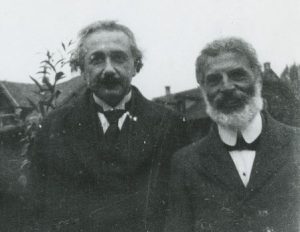Michele Besso was a close friend of Albert Einstein during his days at the Federal Polytechnic Institute in Zurich. Later, Einstein endorsed Besso for a position at the patent office in Bern, and eventually, the two worked there together and grew closer to each other. The warmth and openness of their friendship were captured in Einstein’s letters to Besso.
Besso was born into an Italian-Jewish family in May 1873 in Zurich. He was an engineer, but he had a philosophical fascination with physics. Besso grew up in Italy and was brilliant in mathematics, although at 16, he was suspended from school when he complained that his mathematics teacher was unqualified for the job.
Besso was 23 years old when he met Einstein, who was 17, at the house of a woman named Selina Capriotti. Capriotti was an older woman who often held parties at her place near the lake. Besso came to know that Einstein was a student of physics, while Einstein learned that Besso was working at an electrical machinery firm. Besso already had a deep interest in physics, so it was not surprising that he became immediately interested in his new acquaintance.
Besso and Einstein became more fond of each other during their days at the Swiss Federal Patent Office, where they worked together. After work hours, the two walked home together and talked about scientific matters. Einstein enjoyed these early evening talks with his friend, as years later, he recalled that everyday concerns of life always fell into the background once he and his friend started discussing scientific concepts. When Einstein published his revolutionary theory in 1905, he told his biographer, Carl Seelig, that Besso was the best sounding board in Europe.
By all indications, Einstein felt comfortable discussing all kinds of scientific matters with Besso. It was this intellectual kinship with his friend that helped him openly converse with him about special and general relativity, quantum mechanics, the arrow of time, the expansion of the universe, and many others. Besso was not as versed in physics as Einstein was, but somehow, he was able to converse with him at a level near the physicist. About this, Besso wrote that Einstein was an eagle that took him, the sparrow, to greater heights.
Family matters were no exemption from the two men’s correspondence. In 1916, Einstein wrote to Besso about his son, Hans Albert, saying that he did not write to him and that his son’s attitude towards him had grown cold. He added though, that if he were at his son’s age, he would have behaved in the same way.
Then, in 1921, he narrated to Besso his feelings about his trip to the United States, confiding that he felt like a bull that was displayed in public and had to give endless scientific lectures. He added, though, that it was now over, and despite what he had felt, he believed he had done something good for the Jewish people.
When Einstein and his first wife divorced in 1919, the physicist wrote to Besso that he had lost hope of taking back his son against the wishes of his former wife. He said that he was still rational.
When his friend died in March 1955, Einstein wrote to Besso’s family that the thing he admired most about Besso was that he had lived for many years with only one wife and had maintained good relations with her. He said further that Besso had left this world ahead of him but that does not matter because people like them who were intimate with physics, do not become too carried away with the past, present, and the future, and that those concepts are nothing but persistent illusions.
